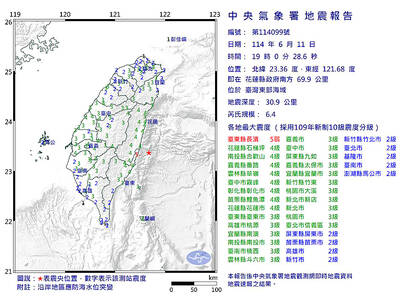As night fell on Baishi Lake (白石池) in Hualien County, a team of hikers camped nearby were heard exclaiming: “Here come the Formosan sambars.”
“There, and there, so many are coming,” the voices said.
As cameras flashed and the hikers turned their headlamps on, the eyes of the approaching sambars were seen shining red in the dark.
Baishi Lake is one of a number of lakes found along the Nenggao Mountain (能高山)-Andongjyun Mountain (安東軍山) trail — a demanding six-day trek in the middle of the Central Mountain Range (中央山脈). The trail has attracted numerous hikers not only for its beautiful scenery, but also for a sighting of the deer.
Undisturbed by the sight of the hikers, the sambars drew closer to the campsite.
“Let’s pee,” some of the hikers said, and some of the male team members proceeded to do so.
Sambars are said to visit human campsites to steal salt and food, and some have been observed licking urine or even sweaty clothes to absorb the salt in them.
Team leader Wu Tai-sheng (吳台生) reminded his members to store their food in their tent so it wouldn’t be trampled on by the sambars, but he left some outside to feed the deer.
The sambars stayed close to the campers’ tents all night. The hikers could hear the sound of their hooves as they paced around, coming so close that sometimes their body would touch the tents.
The following morning, the hikers excitedly took photographs of the sambars, with some staying on until after sunrise and a few daring ones coming within 2m of the hikers.
Huang Ke-yu (黃可喻), a female photographer who has spent a lot of time observing and photographing the behavior of sambars and other wildlife, said Formosan sambars live in mountains with an altitude of about 1,500m, such as the Central Mountain Range, the Yushan Range and the Hsuehshan Range.
The sambars’ population is stable at present, she said.
Sambars rest during the day and are active at night and early morning, Huang said.
“Because Nenggao Mountain-Andongjyun Mountain and Chia-ming Lake (嘉明湖) [a hiking trail in the south Central Mountain Range] are rich in short, arrow bamboos, hikers can easily spot sambars here; but they [sambars] are harder to find in forests or valleys,” the photographer said.
She said sambars approaching people to seek the salt in their urine is their natural behavior, but added that she did not know whether this was because the species around the Nenggao--Andongjyun or Chia-ming Lake trails are used to seeing human beings and are therefore not afraid of people.
“However, if sambars were ever caught or hunted by humans, they would remember the experience and avoid people,” she said.
Huang said sambars are herbivores and could fall sick if they eat hikers’ food.
So don’t feed sambars, she said.
Sambars may also be at risk in mountain areas where national park authorities have ordered cabins be built for hikers.
“When Aboriginal workers constructed cabins deep in the mountains for a national park, they stayed there for several months and hunted sambars for sport. That diminished the number of sambars in the area,” Huang said.
She said when Aboriginal workers constructed two cabins in the Siouguluan Mountain (秀姑巒山) and Dashueiku Mountain (大水窟山) area, the number of sambars there declined, but after the Batongguan Old Trail (八通關古道), a path leading to the Siouguluan-Dashuiku area, was closed for more than two years after being damaged by a typhoon, the number of sambars in the area increased.
In a book by Kano Tadao, a Japanese colonial period pioneer naturalist who explored a number of Taiwan’s high mountains with Aboriginal guides in the 1930s, he described how his Aboriginal guides hunted sambars and other wildlife during the exploration trips.
Nowadays, however, police arrest hunters for killing sambars and taking their horns, which are used to produce traditional Chinese medicine.
Although some Aborigines have called for the government to respect their culture by allowing them to conduct limited hunting — including of protected animals — to maintain their tradition and for use in special ceremonies, Huang said animal protection groups are against the idea.
“Sambars are protected animals. Their only natural enemy is the human race. If they are not hunted by humans, their population in Taiwan could remain stable,” Huang said.
Sambars are herbivores and their existence does not pose a threat to other species in the mountains, she added.

A magnitude 6.4 earthquake struck off the coast of Hualien County in eastern Taiwan at 7pm yesterday, the Central Weather Administration (CWA) said. The epicenter of the temblor was at sea, about 69.9km south of Hualien County Hall, at a depth of 30.9km, it said. There were no immediate reports of damage resulting from the quake. The earthquake’s intensity, which gauges the actual effect of a temblor, was highest in Taitung County’s Changbin Township (長濱), where it measured 5 on Taiwan’s seven-tier intensity scale. The quake also measured an intensity of 4 in Hualien, Nantou, Chiayi, Yunlin, Changhua and Miaoli counties, as well as

Credit departments of farmers’ and fishers’ associations blocked a total of more than NT$180 million (US$6.01 million) from being lost to scams last year, National Police Agency (NPA) data showed. The Agricultural Finance Agency (AFA) said last week that staff of farmers’ and fishers’ associations’ credit departments are required to implement fraud prevention measures when they serve clients at the counter. They would ask clients about personal financial management activities whenever they suspect there might be a fraud situation, and would immediately report the incident to local authorities, which would send police officers to the site to help, it said. NPA data showed

ENERGY RESILIENCE: Although Alaska is open for investments, Taiwan is sourcing its gas from the Middle East, and the sea routes carry risks, Ho Cheng-hui said US government officials’ high-profile reception of a Taiwanese representative at the Alaska Sustainable Energy Conference indicated the emergence of an Indo-Pacific energy resilience alliance, an academic said. Presidential Office Secretary-General Pan Men-an (潘孟安) attended the conference in Alaska on Thursday last week at the invitation of the US government. Pan visited oil and gas facilities with senior US officials, including US Secretary of the Interior Doug Burgum, US Secretary of Energy Chris Wright, Alaska Governor Mike Dunleavy and US Senator Daniel Sullivan. Pan attending the conference on behalf of President William Lai (賴清德) shows a significant elevation in diplomatic representation,

The Taipei City Reserve Command yesterday initiated its first-ever 14-day recall of some of the city’s civilian service reservists, who are to undergo additional training on top of refresher courses. The command said that it rented sites in Neihu District (內湖), including the Taipei Tennis Center, for the duration of the camp to optimize tactical positioning and accommodate the size of the battalion of reservists. A battalion is made up of four companies of more than 200 reservists each, it said. Aside from shooting drills at a range in New Taipei City’s Linkou District (林口), the remainder of the training would be at